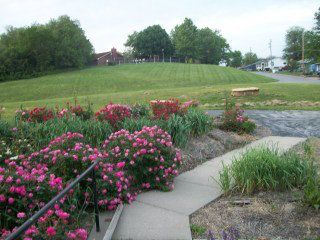If I am starting a new garden and did not have for foresight to take it with me when I moved, I brake when I see it growing along the side of the road. I dig them up and put them in the car. When I get home I take a beat up old screwdriver and make a hole in the spot I want each plant to grow. I stick the plant in and water them and apply a thick hay or leaf mulch. Most every plant survives this rough treatment. They did not always look like they were going to survive in the first year, [some of mine looked deader than doornails] but by the next spring you can tell they are happy and healthy.
The next year I don't harvest any of the plants. But the succeeding year and afterwards, I harvest 1/2 or every other plant and leave the rest. This keeps me in garlic forever.
When I get the plants inside, I clean them, bag them in ziplock bags, and plop them into the freezer. When I need garlic, I take out what I need from the bag and run a little warm water on them or let them sit for a few minutes.
The hardneck garlics were the original selections that evolved from wild garlic. Compared to the softneck types, they often have fewer but larger cloves, are more colorful, and come in a wide range of flavors. They grow well in northern climates, so are often the types seen. Even though they produce a stalk [scape], this should be removed so all the plant energy goes back into producing the cloves. Cut or snap off when sunny so the wound will heal quickly. You can cut up and use the stalk, if harvested when young and tender, for cooking.
I found out recently that the wild garlic I have is a Rocombole variety and what to do with the scapes!
All garlic varieties produce a stem, but it's the hardneck Rocombole garlics that send out the curling scapes that gave them the nickname ‛serpent garlic'. There are many types of Rocombole and the flavor of the scapes can vary considerably from variety to variety, just as with garlic bulbs. But if you have a favorite variety of garlic that grows well in your garden, you will probably enjoy its scapes.
When the scapes are just starting to poke up above the leaves, they are tender enough to eat fresh. Garlic scapes get tougher, the longer they grow. Although they twist and turn and look wonderfully exotic as they grow, they become hotter and more fibrous, requiring some gentle cooking before eating. I cut mine as they are starting their first circle to get the most balanced flavor. Cut, don't pull, the scapes from the plant. The plant will probably ooze a bit, but that will stop when the sun warms it and seals the cut.
Keep in mind that you do not have to cut the scapes at all. Your garlic will still form a bulb, it just won't be as large as it might have been. Some gardeners argue that leaving the scapes on results in a longer storing garlic bulb.
If you harvest your scapes young and tender, you can chop them into salads or use them as a topping, like scallions. More mature scapes can be sauteed lightly and used over pasta, with eggs, mixed with cooking greens, pickled or pretty much in any dish that would be complemented by garlic. My favorite way to use them is to make a garlic scape pesto. I've listed some great recipes to get the juices flowing, below.
There are a lot of scape recipes on the internet too!

